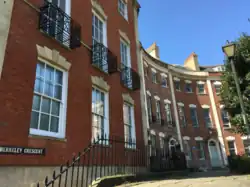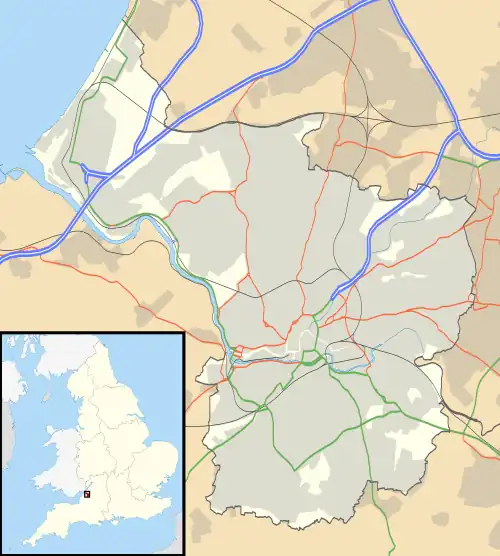Berkeley Crescent, Bristol
Berkeley Crescent is a late 18th-century crescent of six Georgian houses with a private communal garden.
| Berkeley Crescent | |
|---|---|
 Berkeley Crescent Bristol | |
 Location in Bristol | |
| General information | |
| Location | Bristol, England |
| Coordinates | 51.455898°N 2.6088854°W |
| Design and construction | |
| Architect(s) | Paty |
History
It was designed by Thomas Paty (1713–1789) in 1787 and completed in c. 1800, possibly by his son, William Paty (1758–1800).[1] It was originally intended to be part of Berkeley Square. In the 14th century, the site was known as Bartholomew Close.[2]
Numbers 1–6 cover the south and east side of the crescent. The site is designated by the National Heritage List for England: Listed Building Grade II*. The houses are in the mid-Georgian style, constructed in brick with limestone dressings and a slate mansard roof. Each three-storey house has an attic and basement which has a double-depth plan.[3][4] There is a raised flagged pavement with steps at each end.[5]
Location
The Crescent is located within the Park Street & Brandon Hill conservation area [6] between Berkeley Square and the Triangle in the Clifton area of Bristol. The postcode is within the Hotwells and Harbourside ward and electoral division, which is in the constituency of Bristol West.[7] Quarter runs serviced apartments, called Berkeley Suites at 6 Berkeley Crescent. The old Lyndale Hotel was situated at the end of the terrace at 19 Berkeley Square.[8][9]
The Bristol Museum and Art Gallery, Cabot Tower in Brandon Hill Park, and the Wills Memorial Building of the University of Bristol is close by.[10] The Crescent was formerly in the parish of St Augustine the Less and is now in the parish of St. Stephen with St. James and St. John the Baptist with St. Michael, Bristol and St. George Bristol.[11]
Further reading
- Conservation Area 10 Park Street and Brandon Hill Character Appraisal and Management proposals https://www.bristol.gov.uk/documents/20182/33832/park-street-and-brandon-hill-character-appraisal.pdf/e284ea0d-d1a3-48ef-8650-83a87e3cb809
- Central, Clifton and HarboursideNeighbourhood Partnership Statistical Profile 2016. https://web.archive.org/web/20170412143133/https://www.bristol.gov.uk/documents/20182/928407/Central%2C+Clifton+and+Harbourside.pdf/cac587ce-36b5-4e35-903d-3c24ce2b3bd4
References
- Goodge, Mark. "1 to 6 and Attached Railings 19 and Attached Railings, Hotwells & Harbourside, City of Bristol". www.britishlistedbuildings.co.uk. Retrieved 11 April 2017.
- Evans, John (1 January 1824). A Chronological Outline of the History of Bristol, and the Stranger's Guide Through Its Streets and Neighbourhood. Printed at the office of the late "Bristol observer" and pub. by the author.
- "Berkeley Crescent, Clifton, Bristol, Bristol, England – Record Id: 4202". parksandgardens. Retrieved 8 August 2016.
- "1–6 BERKELEY CRESCENT INCLUDING 19 BERKELEY SQUARE". Pastscape. Retrieved 8 August 2016.
- "Berkeley Crescent, Clifton, Bristol". www.parksandgardens.org. Archived from the original on 12 April 2017. Retrieved 11 April 2017.
- Bristol City Council (2011). "Conservation Area 10 Park Street and Brandon Hill Character Appraisal and Management Proposals". Bristol.gov.uk.
- "Area Information for Berkeley Crescent, Bristol, BS8 1HA". Streetcheck. Retrieved 8 August 2016.
- The Vaughan collection (1930). "Lyndale Hotel, Berkeley Square, Clifton, Bristol". archives.bristol.gov.uk. Retrieved 11 April 2017.
- "The Crescent – 5* hotel living in Bristol". Clifton Hotels. Retrieved 8 August 2016.
- "Berkeley Crescent location". Google Maps. Retrieved 8 August 2016.
- "Church of England parish map". arcgis.com. Retrieved 11 April 2017.